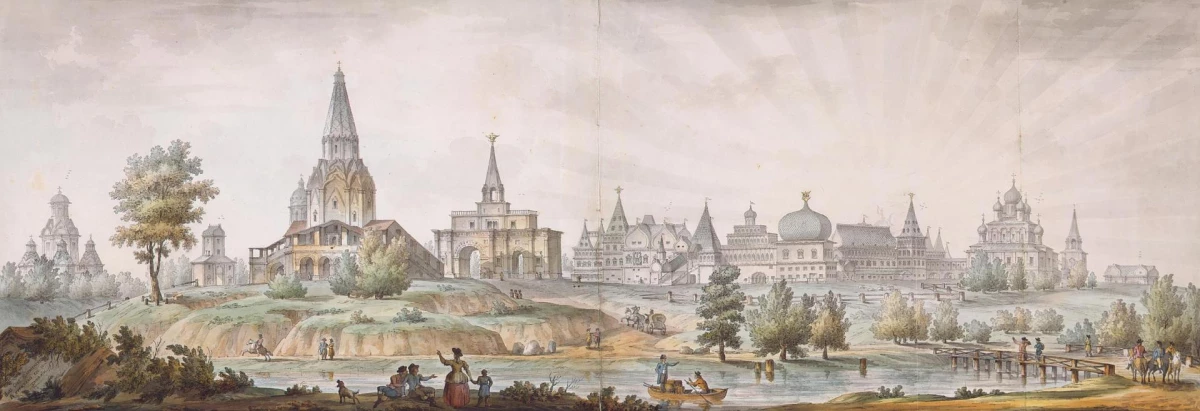
Kolomna is a popular destination for cultural recreation and quiet Muscovites and guests of the capital. In addition to the architectural ensemble, there is a ravine on the territory of the Museum-Reserve, on the shore of which is the Church of the Adoption of the Head of John the Forerunner. At first glance, this is just a quiet place for a walk, however, ravine is attributed to several urban legends at once, one of which gives two boulders with a sacred value, and the other - tells about the disappearance of people and movements in time.
Kolomna
The historical and architectural and natural landscape museum-reserve Kolomna is considered one of the most ancient places of people in the territory of modern Moscow. The history of the place begins in the first millennium BC, when in the area of the future village "Kolomenskoye" there were Selička ancient Finno-Ugric tribes, and according to one of the versions, the name comes from the word "kolomische" denoting the place of mass burial.The first mentions of Kolomensky as a place of life, nobility appear in the will of Ivan Kalita, who passed the settlement in possession of his grandson, prince Vladimir Serpukhovsky.
Later, in the sixteenth century of the land of Kolomensky became a favorite holiday destination Moscow kings, which laid the beginning of the construction of churches and palaces. The first building is considered the Church of the Ascension of the Lord, laid for praying for the birth of children in the Grandnya Chet and first mentioned in the chronicles from 1532.
Gradually, the park ensemble began to develop. For several centuries, new buildings appeared, some collapsed, some rebuilt, and only in 1923 it was decided to create an architectural and park museum in Kolomensky. Work was carried out for several years, then were postponed and resumed only in the 1960s.
Now the museum expands, new zones appear on its territory, recover and open up for visiting new unique architectural monuments.
But in addition to architecture, Kolomna is famous for mystical stories.
Votes Orag.
On the territory of Kolomensky there is a natural attraction - votes of the ravine. The name of the votes (or venee / hairs) is due to the name of the Slavic God of Wisdom, Veles, the patron saint of three worlds and all cyclic processes. The ravine with steep slopes has a length of a more kilometer and divides the park into two parts. Not far from the ravine archaeologists found the remnants of the settlements of people dating back to the first century BC.
Miracle stones
The proximity of ancient settlements contributed to the emergence of the legend of miraculous stones.According to legend, in this place the battle of George Victoriousness with a snake was held. Potioned snakes, falling on the ground, turned into a ravine. In place, where the horse shed his blood, one stone was formed with a smooth surface. This stone lies on the slope of the ravine and are now referred to as "Giroba Stone". It is believed that the stone helps women to find family happiness and promotes the conception of the child. Where the horse fell, at the bottom of the ravine, there was a second stone, and for pupil, like a goose leather surface, he was called "Gus-Stone". According to believe, goose-stone helps men, brings success and good luck.
In fact, there is an assumption that the stones remained from the Slavic sanctuary, and the altar in honor of Veles was in the place of one stone, and in the place of the second - in honor of the Supreme God Perun. The legend of miraculous properties appeared in the 1980s and still attracts tourists.
Gate time
In addition to miraculous boulders, there are several legends associated with movements in time.
The first case can be found in the annals of 1621, when the Tatar Connection was found in the ravine near the Tsarskoy Palace, although at that time the Tatar was not seen in Moscow for more than 50 years. The army grabbed, and in the inquiry it turned out that it was saved from Russian warriors during the expulsion of Khan Devlet-Girea. Going into the ravine, the army passed through the fog and turned out to be in another time.
Another case was described in the Moscow Vedomosti newspaper from 1832. The record told about two peasants, Archipa Kuzmin and Ivan Bochkarev, who returned in the evening to the next village through the votes of the ravine and disappeared. They came out in the same place, but after 21 years. The peasants did not change outwardly and were surprised that they had been considered missing, because for them everything was like a moment.
After that, it was decided to conduct an experiment: at night, when fog thickened over the ravine, one peasant was sent to walk through the ravine, he disappeared and his further fate is unknown.
According to the documents of the Kolomenskaya volost, during the period from 1825 to 1917, people have repeatedly disappeared in those places, and sometimes there were a long missing, and all as one stated that they just went to the ravine just.
The votes of the ravine to this day are called the place of power. Someone comes to the execution of desires, someone to check the city legend. Believe it or not, to solve only you, but is unambiguous that the lands of Kolomensky are rich in their history, attractive to beautiful nature and unique architecture.
